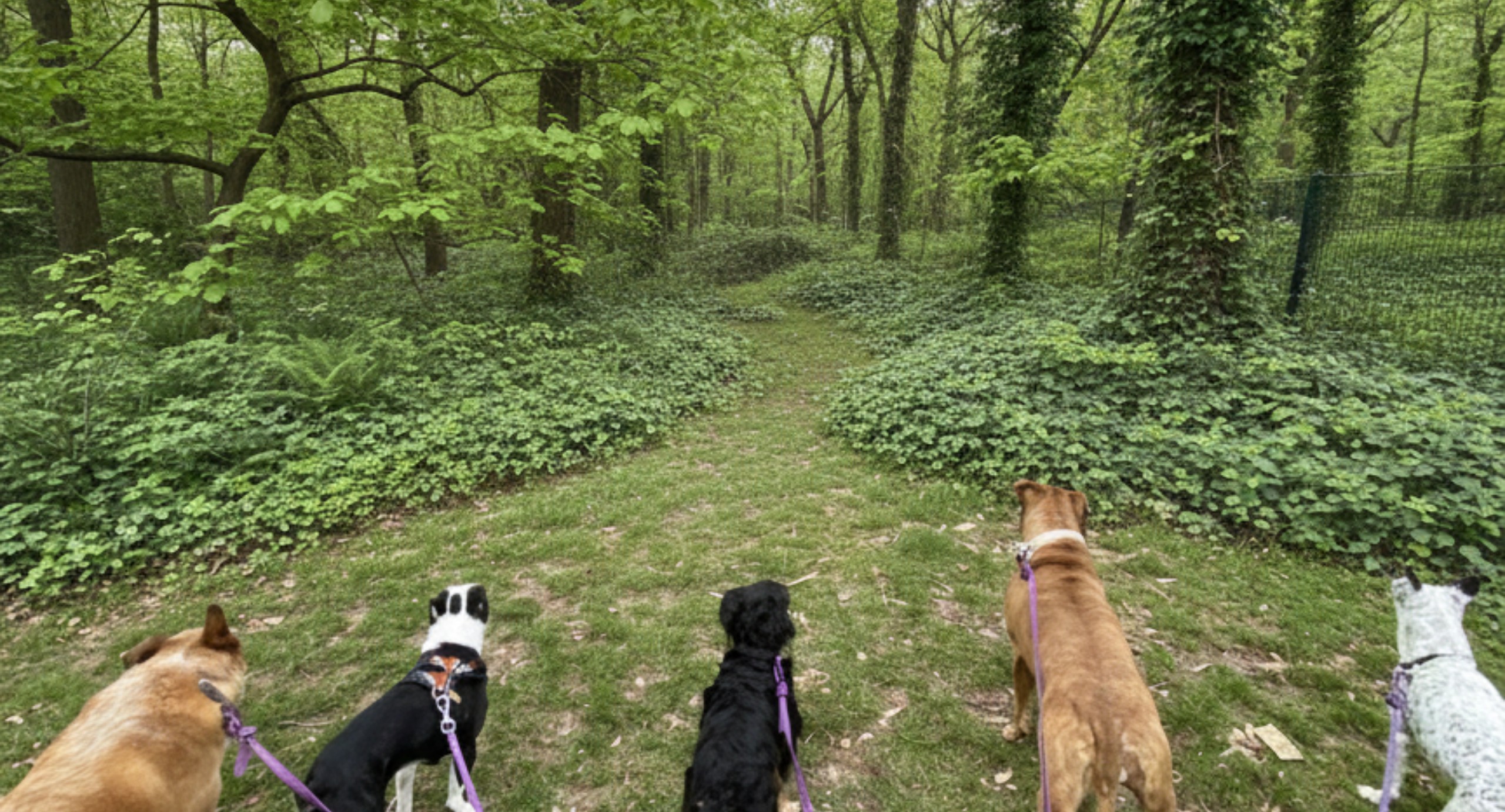Description of a Mission
A mission, seen from the inside.
Most dogs arrive to me with the same look — alert, restless, scanning for something to do.
Not anxious. Not “bad.”
Just underworked in a city that offers them too much noise and too little meaning.
So let me tell you what a real Dog Mission looks like from the inside.
Not the polished version.
The actual, on-the-ground experience that reshapes dogs week after week.
We Start at the Edge of the Park
Before we step off pavement, the pack forms its early rhythm — small cues, subtle adjustments.
Who’s decisive today.
Who’s watching from the side.
Who’s already trying to lead with their nose.
I say nothing.
I just walk.
The trailhead does the talking.
The moment we cross into the forest edge, something changes.
Shoulders drop.
Breathing slows.
Scanning becomes purposeful instead of frantic.
This is the first shift: from city pulse to mission focus.
The Trail Chooses the Work
I never pick a route because it’s pretty.
I pick it because it asks something specific from the dogs.
Today it’s a mix:
- narrow trail with exposed roots
- two moderate climbs
- a scent corridor that always lights up the group
- a long, steady descent toward water
Each section has a job.
Climbs build controlled effort.
Roots demand coordination.
Scent corridors activate the mind.
The descent teaches pacing and balance.
A sidewalk can’t do this.
Terrain gives dogs the work they’re built for.
The Pack Begins Its Own Conversation
You’d miss it if you weren’t looking for it.
- A young shepherd tries to surge ahead — the group ignores it. He folds back in.
- A shy doodle hesitates at a narrow pass — the older lab steps through confidently, and she follows.
- Two dogs drift too close — I adjust pace, open space, and the tension dissolves without a sound.
Nothing here is random.
A mission is a moving classroom, and the pack is the teacher.
Dogs learn faster by watching than by being told.
Reading the Rhythm
Half a mile in, the group settles.
Stride length synchronizes.
Breathing aligns.
Movement becomes predictable.
This is where I start making adjustments:
- Who needs more decompression
- Who needs a challenge
- Who’s hiding overexcitement behind “happy energy”
- Who’s showing early fatigue
- Who’s ready for more complexity
A mission isn’t linear — it breathes.
I guide it, but the pack sets the tempo.
The Water Crossing
Most missions include some form of threshold — not a test, not a trick, just a natural break in the terrain.
Today it’s shallow water.
A few dogs wade in without thinking.
Others hesitate at the edge, scanning the ripples.
One tries to flank the group and avoid it — classic avoidance pattern.
I don’t coax.
I don’t lure.
I simply stand in the water and wait.
One by one, they choose to follow.
Their posture after crossing always changes — more grounded, more certain.
Confidence grows through action, not reassurance.
The Long Middle Stretch
This is where the real work happens.
A steady, rhythmic trail — not too stimulating, not too dull.
Here dogs drop into a working state:
- no frantic sniffing
- no darting
- no scanning in all directions
- just purposeful movement
This is the part owners never see, because it doesn’t photograph well.
But it’s the heart of the mission.
A dog in rhythm is a different dog.
The Descent Into the Valley
The terrain tightens.
I bring the group into a narrow formation.
This teaches:
- spatial awareness
- respecting pace
- controlled excitement
- listening to the pack’s movement
A dog that was restless at the start now watches the path carefully, adjusting each step.
Another that pulled earlier now matches the group pace without tension.
You can see their nervous systems smoothing out — not tired, but organized.
The Final Climb
We hit the last incline.
This is where stamina shows.
Some dogs power through with steady effort.
Others slow, but with determination.
A few want to cut corners — I redirect gently, no words.
At the top, nobody is overexcited.
Nobody is frantic.
The pack just stands, breathing deeply, grounded.
This is what balance looks like in real life.
Exiting the Trail
When we step back onto pavement, the group is different.
- Tails neutral
- Eyes softer
- Movement deliberate instead of chaotic
- The younger ones mimic confidence instead of adrenaline
This is the outcome of the work — not a “tired dog,” but a regulated dog.
When we return home, owners notice:
- better sleep
- easier settling
- less reactivity
- more presence
- calmer evenings
They think it’s magic.
It’s not.
It’s structure.
The Week Has a Rhythm Too
A single mission helps.
Regular missions transform.
Over a week:
- Day 1: shake off tension
- Day 2: settle into the pattern
- Day 3+: move like part of the pack
Dogs begin anticipating the work.
They conserve energy.
They arrive focused.
Their baseline shifts from reactive to stable.
This is the long-term value of consistency.
Over Time, Dogs Change
Not dramatically.
Not instantly.
Steadily.
They become:
- physically stronger
- more coordinated
- more aware of their body
- less overwhelmed by stimulation
- more confident in new spaces
- quicker to recover after excitement
Their gait changes.
Their breath changes.
Their posture changes.
What changes most is their relationship with challenge.
They stop bracing and start meeting the world head-on.
A Mission Is Not a Walk
A walk fills time.
A mission fills a need.
What you’ve just read is what actually happens inside these excursions — the structure, the decisions, the rhythm, the subtle work that doesn’t show up on GPS or in a photo.
Prospect Park makes it possible.
Consistency makes it effective.
The pack makes it powerful.
And the dog, finally, gets the one thing city life rarely gives them:
Purpose.

